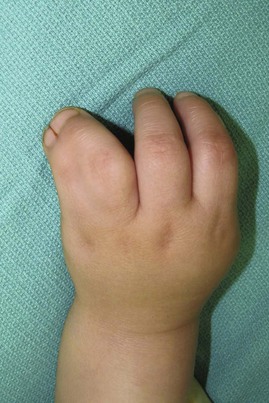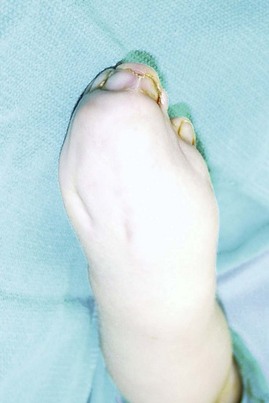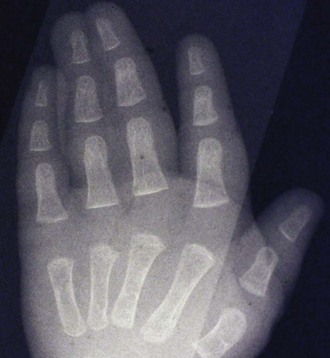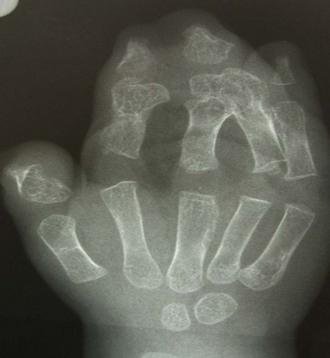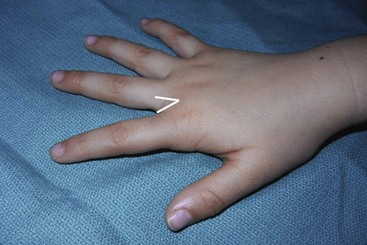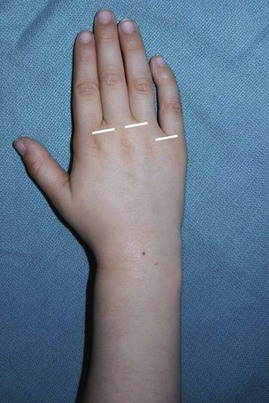Procedure 36 Syndactyly Release
![]() See Video 29: Syndactyly Release and Skin Grafting
See Video 29: Syndactyly Release and Skin Grafting
See Video 30: Syndactyly Release with Pentagonal Flap
Indications
 Syndactyly release is indicated to improve aesthetic appearance, alleviate functional limitations, and prevent deformity due to growth restriction.
Syndactyly release is indicated to improve aesthetic appearance, alleviate functional limitations, and prevent deformity due to growth restriction.
 Syndactyly release is usually performed between 12 and 18 months of age when the anatomic structures are larger and anesthesia is safer compared with younger ages. Long-term results are not compromised by waiting longer, although it is preferable to complete surgery before the child enters nursery school. An earlier release at about 6 months of age should be considered in children with syndactyly of the fourth web because the difference in length of the ring finger and small finger can lead to angulatory and rotatory deformities. Similarly, in children with complicated syndactyly, the first web space should be released at an earlier age.
Syndactyly release is usually performed between 12 and 18 months of age when the anatomic structures are larger and anesthesia is safer compared with younger ages. Long-term results are not compromised by waiting longer, although it is preferable to complete surgery before the child enters nursery school. An earlier release at about 6 months of age should be considered in children with syndactyly of the fourth web because the difference in length of the ring finger and small finger can lead to angulatory and rotatory deformities. Similarly, in children with complicated syndactyly, the first web space should be released at an earlier age.
 If the syndactyly involves more than one web space, it is safer to release contiguous web spaces at separate stages to avoid disrupting the blood supply to the finger between the web spaces.
If the syndactyly involves more than one web space, it is safer to release contiguous web spaces at separate stages to avoid disrupting the blood supply to the finger between the web spaces.
Examination/Imaging
Clinical Examination
 Syndactyly is classified by the extent of fusion and the elements that are fused. Complete syndactyly involves the entire length of the fingers from the web to the tip (Fig. 36-1), whereas incomplete does not involve the entire length (Fig. 36-2). Simple syndactyly involves fusion of the skin only. Complex syndactyly describes fusion of the phalanges, usually the distal phalanx. Complicated syndactyly refers to fusion of multiple digits and is typically associated with other congenital anomalies such as Apert or Poland syndrome (Fig. 36-3).
Syndactyly is classified by the extent of fusion and the elements that are fused. Complete syndactyly involves the entire length of the fingers from the web to the tip (Fig. 36-1), whereas incomplete does not involve the entire length (Fig. 36-2). Simple syndactyly involves fusion of the skin only. Complex syndactyly describes fusion of the phalanges, usually the distal phalanx. Complicated syndactyly refers to fusion of multiple digits and is typically associated with other congenital anomalies such as Apert or Poland syndrome (Fig. 36-3).
Surgical Anatomy
 The web space is U shaped, with a 45-degree slope from the metacarpal head to the midproximal phalanx (Fig. 36-6). The web space of the index and long finger is at the same level, whereas the web space of the fourth web is more proximal (Fig. 36-7).
The web space is U shaped, with a 45-degree slope from the metacarpal head to the midproximal phalanx (Fig. 36-6). The web space of the index and long finger is at the same level, whereas the web space of the fourth web is more proximal (Fig. 36-7).
General Principles
 The new web space should be created more proximal than normal to account for web creep with growth of the child.
The new web space should be created more proximal than normal to account for web creep with growth of the child.
 A flap should be used to resurface the web space. The use of skin grafts should be avoided in the web spaces.
A flap should be used to resurface the web space. The use of skin grafts should be avoided in the web spaces.
 An interdigitating flap design should be used for coverage of digits. However, if primary flap closure is tight, there should be no hesitation in using a full-thickness skin graft.
An interdigitating flap design should be used for coverage of digits. However, if primary flap closure is tight, there should be no hesitation in using a full-thickness skin graft.
Procedure
Release of Simple Complete Syndactyly
Exposures
 A proximally based dorsal rectangular flap for web reconstruction, along with interdigitating flaps, is used.
A proximally based dorsal rectangular flap for web reconstruction, along with interdigitating flaps, is used.
 The proximally based dorsal rectangular flap is designed by marking the metacarpal heads and a point on each digit at the midpoint of the proximal phalanx. The points are connected to form a proximally based flap with its base at the level of the metacarpal heads (Fig. 36-8).
The proximally based dorsal rectangular flap is designed by marking the metacarpal heads and a point on each digit at the midpoint of the proximal phalanx. The points are connected to form a proximally based flap with its base at the level of the metacarpal heads (Fig. 36-8).
 The interdigitating flaps are designed as two Zs, one on the dorsum and the other on the palmar surface, such that they form mirror images. The dorsal Z is designed first and connects the following four points sequentially (Fig. 36-9):
The interdigitating flaps are designed as two Zs, one on the dorsum and the other on the palmar surface, such that they form mirror images. The dorsal Z is designed first and connects the following four points sequentially (Fig. 36-9):
 For the flaps to interdigitate, the tips of the palmar and dorsal Zs must oppose each other. A 25-gauge needle is inserted through the skin from the dorsum to the palmar surface at the same level as the tip of the proximal dorsal flap (point B), and a palmar flap is designed such that the tip is on the other finger (Fig. 36-10A
For the flaps to interdigitate, the tips of the palmar and dorsal Zs must oppose each other. A 25-gauge needle is inserted through the skin from the dorsum to the palmar surface at the same level as the tip of the proximal dorsal flap (point B), and a palmar flap is designed such that the tip is on the other finger (Fig. 36-10A
Stay updated, free articles. Join our Telegram channel

Full access? Get Clinical Tree



